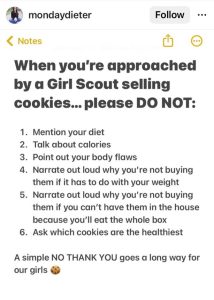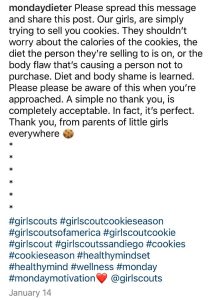In case you missed it, there was a post that went viral that is worth talking about and sharing for National Eating Disorders Awareness Week.


This post was created by the Instagram handle @mondaydieter. The profile shares that her name is Nicole Romanella O’Neal. She is a mother, a disordered eating recovery advocate, and a registered dietitian nutritionist grad student. Her post, a simple yet meaningful message, kindly requests that folks refrain from the following when approached by a Girl Scout selling cookies.
“Please DO NOT:
Mention your diet
Talk about calories
Point out your body flaws
Narrate out loud why you’re not buying them if it has to do with your weight
Narrate out loud why you’re not buying them if you can’t have them in the house
Ask which cookies are the healthiest
A simple NO THANK YOU goes a long way for our girls”
In the spirit of “get in the know,” here are some facts that support why this message is so important and relevant to eating disorder awareness.
- Fear of weight gain, feeling like one is overeating, feelings of guilt, thinking about dieting, and a desire for thinness are predictive of eating disorder severity.
- 62.3% of teenage girls and 28.8% of teenage boys report trying to lose weight. 58.6% of girls and 28.2% of boys are actively dieting. 68.4% of girls and 51% of boys exercise with the goal of losing weight or to avoid gaining weight.
- A cohort study found that females who dieted moderately were five times more likely to develop an eating disorder, and those who practiced extreme restriction were 18 times more likely to develop an eating disorder than those who did not diet.
- Studies have shown that about 50% of preadolescent girls and 30% of preadolescent boys dislike their body.
- 22% of children and adolescents worldwide show disordered eating.
- Black teenagers are 50% more likely than white teenagers to exhibit bulimic behavior, such as bingeing and purging.
- Nearly 9 in 10 (87%) LGBTQ youth reported being dissatisfied with their body.
Eating disorders are comprised of biological, psychological, and sociological factors.
The Girl Scouts community consists of children as young as 5 and 6 years old through adolescents and teenagers. These are formative years and can also include puberty, where the body is going through significant change. Puberty is one of many biological risk factors for eating disorders.
Diet culture is pervasive and often normalized due to weight stigma. Many people may not know that talking about weight loss, pointing out your perceived body “flaws,” checking calories or grams of sugar or fat, and basing your intake on the nutritional facts are all a part of diet culture. These messages can be attributed to sociological factors that can put one at risk for an eating disorder.
Psychological risk factors can include perfectionism, impulsivity, body image dissatisfaction, and emotional dysregulation. These traits can be common in children, adolescents, and teens (the Girl Scout community).
Eating habits and food choices are deeply personal, individual, and complex. Your personal opinion on your food and body image can be vastly different from others. That’s your business. To echo the message of the viral post — Please don’t go sharing your business with vulnerable people or people who did not ask to hear it.
Written by:
Leah Morgan, RD, CEDS (she/her/hers)
Director of Nutrition and Wellness
Certified Eating Disorder Specialist
Licensed Be Body Positive Facilitator
Sources:
Eating Disorder Statistics – National Eating Disorders Association https://www.nationaleatingdisorders.org/statistics/#dieting-and-eating-disorders
Levinson, C. A., Hunt, R. A., Christian, C., Williams, B. M., Keshishian, A. C., Vanzhula, I. A., & Ralph-Nearman, C. (2022). Longitudinal group and individual networks of eating disorder symptoms in individuals diagnosed with an eating disorder. Journal of Psychopathology and Clinical Science, 131(1), 58. doi:https://doi.org/10.1037/abn0000727
National Center on Addiction and Substance Abuse (CASA) at Columbia University. (2003). Food for Thought: Substance Abuse and Eating Disorders. New York, National Center on Addiction and Substance Abuse.
Patton, G. C., Selzer, R., Coffey, C., Carlin, J. B., & Wolfe, R. (1999). Onset of adolescent eating disorders: Population based cohort study over 3 years. BMJ, 318(7186), 765–768. https://doi.org/10.1136/bmj.318.7186.765
Alleva, J. M., Sheeran, P., Webb, T. L., Martijn, C., & Miles, E. (2015). A Meta-Analytic Review of Stand-Alone Interventions to Improve Body Image. PloS one, 10(9), e0139177. https://doi.org/10.1371/journal.pone.0139177
López-Gil, J. F., García-Hermoso, A., Smith, L., Firth, J., Trott, M., Mesas, A. E., Jiménez-López, E., Gutiérrez-Espinoza, H., Tárraga-López, P. J., & Victoria-Montesinos, D. (2023). Global Proportion of Disordered Eating in Children and Adolescents. JAMA Pediatrics. https://doi.org/10.1001/jamapediatrics.2022.5848
Kennedy, H. L., Dinkler, L., Kennedy, M. A., Bulik, C. M., & Jordan, J. (2022). How genetic analysis may contribute to the understanding of avoidant/restrictive food intake disorder (ARFID). Journal of eating disorders, 10(1), 53. https://doi.org/10.1186/s40337-022-00578-x
Goeree, M.S., Ham, J.C., & Iorio, D. (2011). Race, social class, and bulimia nervosa. IZA Discussion Paper No. 5823. https://dx.doi.org/10.2139/ssrn.1877636
The Trevor Project. (2022). Research Brief: Eating Disorders among LGBTQ Youth. https://www.thetrevorproject.org/research-briefs/eating-disorders-among-lgbtq-youth-feb-2022/








